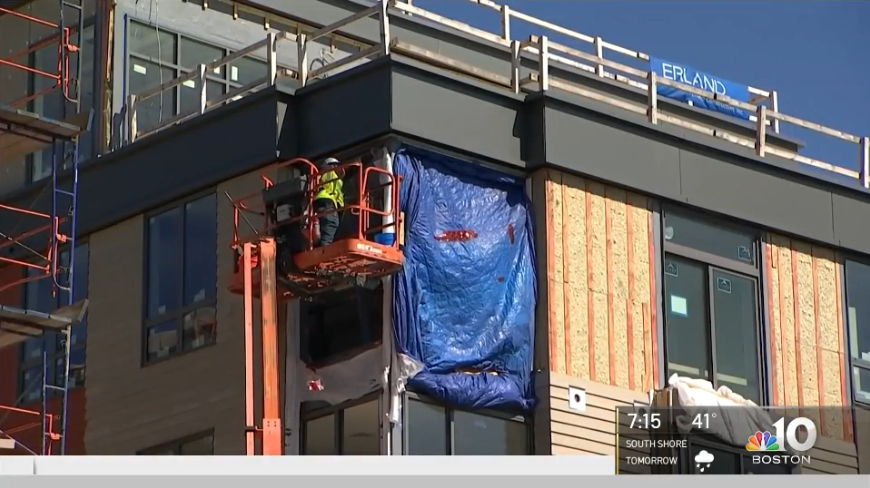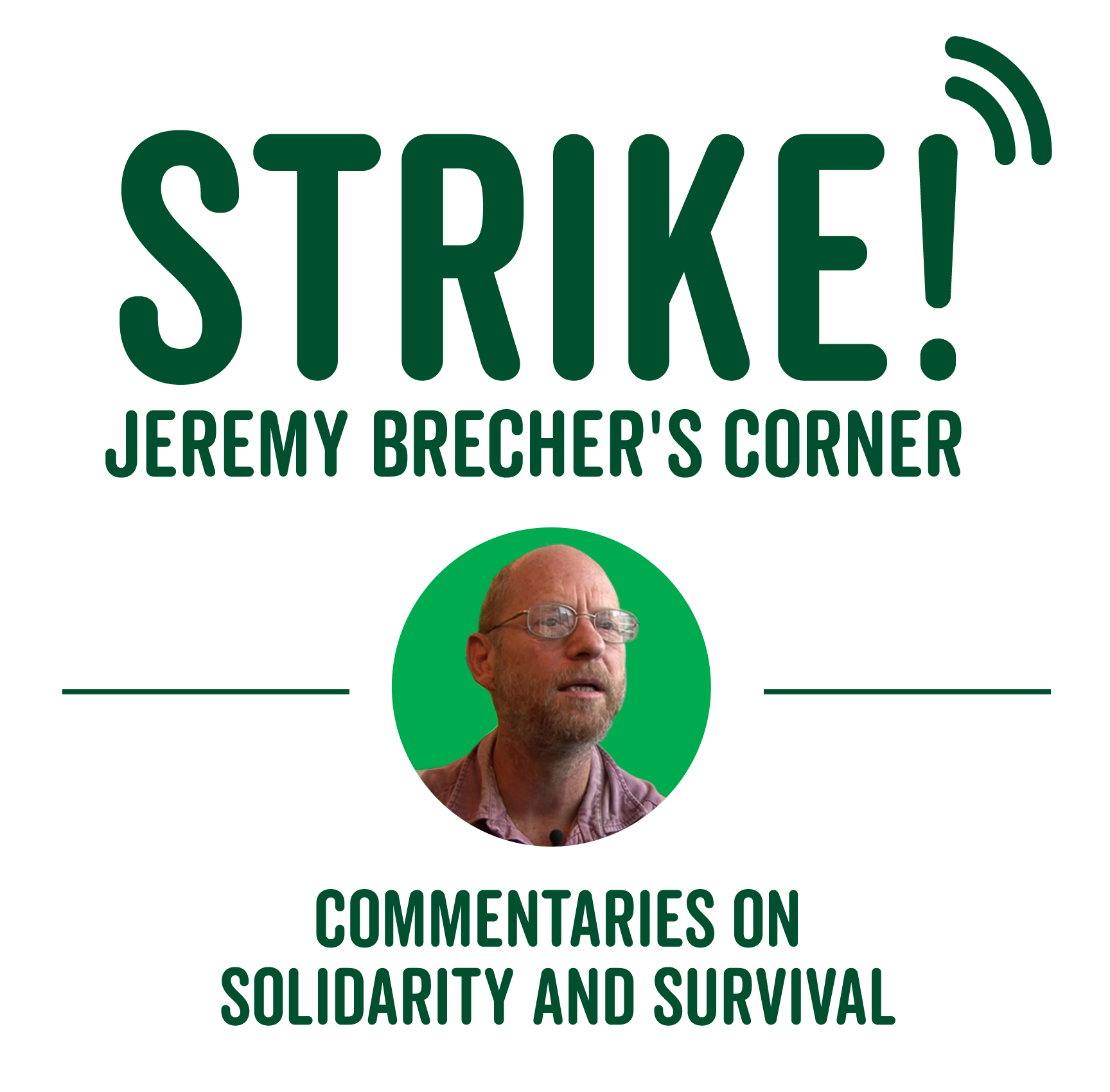Listen to the audio version >>
As we enter an era of constitutional crisis, contested government, intensifying pandemic, and mass economic disruption, the future of democracy will depend on popular mobilization. The earlier commentary “Fighting the Great Depression – From Below” described the grassroots unemployed, self-help, labor, and other movements of the early years of the Great Depression. “The Unemployed vs. the Coronavirus Depression,” “Self-Help in the Coronavirus Depression,” “Striking in the Coronavirus Depression,” and “Workers vs. the Coronavirus Depression” described the recent stirrings of grassroots action for health and economic protections in the coronavirus era. This commentary examines the grassroots response to the coronavirus as a whole. An upcoming commentary will examine the role of people power in the period of turmoil that lies ahead.

The Coronavirus pandemic and the economic depression accompanying it are already engendering new movements of both employed and unemployed workers. In some ways these resemble the worker and unemployed movements that emerged in the first years of the Great Depression; in other ways they are very different.
The early years of the Great Depression saw the emergence of new forms of popular action in response to the devastating economic conditions workers faced. Unemployed workers organized in Unemployed Councils; used “eviction riots” to protect renters; marched and occupied city halls and state capitols to demand food, jobs, and relief; organized quasi-unions in government jobs programs; and fought for legislation to provide for the needs of the unemployed. Unemployed workers in hundreds of cities created mutual aid organizations that produced and distributed goods like food and firewood and services like carpentry and health care. While the early years of the Great Depression saw a rapid decline in unions and conventional strikes, they also saw the rise of self-organized strikes and local horizontal worker organizations.

Photo: Cleaner sweeping floor after the Wall Street crash, 1929. Source, Wikimedia.
Some of the differences between the Great Depression and today are evident. While the Great Depression was heralded by the 1929 stock market crash, the continuing growth of mass unemployment–though rarely discussed by politicians or the press–continued for three years. The coronavirus pandemic came on suddenly as did the accompanying Coronavirus Depression. The Great Depression had no visible cause outside the economic system itself; today’s economic crisis is easily, if too simplistically, blamed on the virus rather than the economic system. Social distancing and other public health restrictions severely restrict mass action. Conversely, social media have proved to be powerful vehicles for organizing. In contrast to the early years of the Great Depression, this time the federal government initially responded rapidly with expanded unemployment insurance and other income support, forestalling though not eliminating some of the mass desperation that marked the early 1930s. The issues of health had a centrality in the coronavirus era because of the COVID-19 pandemic and the wider crisis of the healthcare system.
The movements of the early 1930s often won some benefits for participants and other working people that ameliorated their misery and helped them to survive under depression conditions. These movements often put significant pressure on governments to be more responsive to the needs of workers and the poor. The outbursts of employed and unemployed created a fear–or hope–of fundamental social and economic change, putting the legitimacy and the viability of the status quo into question. And these movements helped develop the ideas, capacities, and networks that underlay the New Deal and the extensive worker organizing of the later 1930s.

Caption: 1937 Dorothea Lange photograph of a young Filipino man in Santa Maria, California. Source: Wikimedia.
How do the results of the movements of the coronavirus era compare to those of the early Great Depression? The unemployed networks and the action of the unemployed that started in March, 2020 have been effective in helping meet some of the immediate needs of the unemployed. They provided guidance for individuals frustrated by the bureaucracies that were supposed to provide unemployment benefits and other services. They successfully pressured states to expand services and fix glitches in providing them. They mobilized pressure to expand the federal stimulus packages and make them more inclusive. The threat of rent strikes and other tenant actions helped pressure dozens of states, and ultimately the federal government, to halt evictions. Burgeoning self-help and mutual aid activities have helped tens of thousands to get by in distressed circumstances and helped build communities out of the isolation of pandemic and unemployment. The hundreds of coronavirus wildcat strikes and the many less visible actions by union and non-union workers have won previously denied health and economic protections for thousands of workers. National mass actions like the Strike for Black Lives and the wave of teacher actions for safe school reopenings have already had a significant impact on the crucial national issues of racial justice and education policy.
While the coronavirus pandemic and the massive unemployment it generated created a sense of social crisis, the unemployed and worker movements themselves have not yet created the atmosphere of looming upheaval that the unemployed movements did in the early 1930s. However, the concentration of both COVID-19 and the resulting mass unemployment in African American communities are undoubtedly factors in the Black Lives Matter uprising that followed the police killing of George Floyd, which the The New York Times characterized as by far the largest protest movement in American history.[1]
The movements of the unemployed are beginning to interact with Black Lives Matter. Shanti Singh, communications coordinator for Tenants Together, a statewide California coalition of local tenant organizations, says, “If all of these evictions are enforced, who throws your stuff out onto the street? It’s the cop, it’s the sheriff.” We need to “recognize the role of police enforcement in the eviction machine” and “fight back against that specifically.”[2] Journalist Candice Bernd projects the specter that “Rising Black and Brown unemployment coupled with mass evictions” could spark “renewed uprisings in the streets.”[3] Such things have happened before: In Depression-era Chicago, Black sociologists St. Clair Drake and Horace Cayton described “something new”: “Negroes and whites together rioting against the forces of law and order.”[4]
New forms of organization and action
Above: This compilation of street scenes in Chicago include a Nov. 24, 1934 demonstration for unemployment relief.
Author: Paul Snow. Watch the video »
Mobilizing “people power” under pandemic conditions has required a high level of creativity both in organization and in tactics. Forms of action are not only different from those of the Great Depression, but from more recent pre-COVID era struggles as well. Here are some examples:
Motorcades, socially-distanced gatherings, and on-line rallies have often become the initial means of public action under pandemic conditions. Social media platforms like Facebook, WhatsApp, TikTok, and Instagram have become crucial means for self-organization.
Mike Elk of Payday Report says protest strikes associated with Black Lives Matter often enlist support from Black and Brown small business owners. “The closures put pressure on other business owners to close during these protests or to stop work to address issues of racial inequality.” In Chattanooga, Tennessee, “Black workers working with I Can’t Breathe CHA were able to get more than 44 businesses closed as part of a call for a strike.”[5]
In West Virginia, a campaign for governor turned its field operation into a “COVID Crisis Response Team.” Three hundred and eighteen “neighborhood captains” volunteered to check in weekly on 100 of their neighbors each–making sure they have the food, medicine, unemployment benefits, and absentee ballots they need.[6]
Teachers’ unions have formed medical panels of pediatricians to determine whether districts are creating safe environments for the teachers being asked to go into the classroom this fall.[7]
Joseph B. Atkins, professor of journalism at the University of Mississippi, writes that there have been more than 230 strikes and other job actions in the meatpacking industry in the Carolinas and elsewhere in the South in the six months since the pandemic began, many of them among African American and Latino workers. The activist group the Southern Workers Assembly has organized a Safe Jobs Safe Lives campaign in the meatpacking industry. In northwest Arkansas, the “non-traditional” worker justice organization Venceremos led a march to the front door of Tyson corporation’s poultry plant in Springdale demanding better working and safety conditions and hazard pay during the pandemic.[8]
In Connecticut, trade union activists from multiple industries, occupations, and unions called for an “emergency labor response to the COVID-19 crisis.” They issued a statement signed by 200 workers, including hotel workers, food service workers, educators, grocery store workers, draftsmen, social workers, electricians, teamsters, pilots, barbers, HVAC technicians, and numerous others. Signers were listed by union, with a special category for “Non-union/Unemployed workers.” They presented a plan of action that represented a full suite of policies needed to protect workers during the pandemic, including: testing, hazard pay and childcare for essential workers; leave with full pay and benefits for all non-essential workers; health care, insurance, housing, utilities, and other needs to be met during the crisis; protection of collective bargaining, privacy, and other rights; and health care provisions including testing, production of PPE, and emergency hiring of healthcare workers; and many other demands.
The signers organized the Connecticut Workers Crisis Response, whose campaign for these measures included a Mayday rally with 200 cars surrounding the state capitol in Hartford and an on-line rally broadcast live; a “cancel rent” caravan; a regular Educator Working Group; publication of a newsletter; webinars on hot topics like the “reopening” of the state; social media work; and organizing solidarity support for various groups of workers threatened by their employers’ health protection failures.[9]
The state of Ohio emailed employers urging them to report workers who were collecting unemployment benefits while refusing to work–even in unsafe conditions–so they could be denied unemployment. However, a “hacker” developed a code that lets anyone submit fake information to the site. According to Vice, the hacker said his goal was to overwhelm the system with incorrect information, which would make it harder for the state to deny people benefits. Shortly thereafter the state announced it was re-considering the policy.[10]
Unions and Strikes
North Atlantic States Regional Council of Carpenters

Author: NBC Channel 10, Boston. Watch the video »
These actions had varied relations to unions. Some were union-organized. On April 6, for example, the North Atlantic States Regional Council of the Carpenters’ union led a strike for Covid-19 protections by 13,000 Massachusetts carpenters.[11] On the same day, National Nurses United held walkouts at 15 HCA-Healthcare-owned hospitals in six states.[12] Some, like a Detroit bus drivers’ walkout, were organized by rank-and-file workers but won union support. There is anecdotal evidence that some wildcats may have received sub rosa union encouragement, while in other cases unions have encouraged or ordered their members back to work. Some strikes were organized by non-union worker groups, such as the Instacart Shoppers and Gig Workers Collective and the NC Raise UP, an affiliate of the SEIU-backed Fight for $15.
By May 12 the website Payday Report added their 200th work stoppage for coronavirus protection to their wildcat strike tracking map. Today it is over 900. Why are so many of these wildcats – strikes conducted without official union backing? Of course the great majority of U.S. workers don’t have union representation so their strikes are bound to be “wildcat.” But even where unions have bargaining rights they are usually constrained from striking both by U.S. labor law and by their contracts with their employers.[13]
While unions have demanded and bargained for Personal Protective Equipment, public health practices, and hazard pay, so far they have rarely engaged in strikes to get them.[14]
Robert Combs of Bloomberg Law explained why:
One reason why most of the coronavirus-related strike activity has taken place outside of organized labor, rather than within, is that it’s easier for nonunion workers to walk off the job, as long as they do it together. Many union employees, on the other hand, are limited by certain “no-strike” clauses in their collective bargaining agreements. These provisions restrict a union local’s ability to call a strike while the CBA is in effect. Although there are exceptions to these clauses that adept labor leaders can use if needed, it is often a wise choice to let some protests occur on a grassroots level. As long as they don’t rise to the level of a wildcat strike—that is, a full-on strike not called by union locals, which can raise doubts about that local’s ability to represent its workers—such protests can give unions the cover they need to advocate for their workers without triggering claims of unfair labor practices.[15]
Labor leadership was certainly busy in the early weeks of the outbreak, but its role mostly revolved around supporting and promoting workplace protests that have sprung up organically by employees required to remain on the job while most of the workforce stays at home.
Most of these protests have stopped short of being defined as “strikes” by their union leaders. For example: an impromptu rally by Pittsburgh sanitation workers demanding hazard pay and better personal protective equipment; a pair of silent demonstrations at a General Electric factory in Lynn, Massachusetts, to complain about safety conditions and to agitate for switching production to ventilators; and a single-shift walkout by 19 painters at a Fiat Chrysler plant in Warren, Michigan, to protest the company’s response to worker illnesses.
Combs says that “nonunion walkouts fill the void.”
The lack of union activity doesn’t mean that there haven’t been coordinated, large-scale strikes in these turbulent weeks. Quite the opposite: Work stoppages have made headlines almost every day. But most of these walkouts have been organized by unorganized workers—that is, employees in nonunion companies.[16]
But that’s not the whole story. One of the significant developments of the coronavirus era is that some unions are beginning to move toward support of actions by their members that violate their contracts and even the law.[17] Illinois Education Association President Kathi Griffin for example, recently said,
No avenue or action is off the table – the courts, the Illinois Educational Labor Relations Board, nothing, including health and safety strikes. The entire weight of the IEA and the IFT will be used in whatever way is necessary to protect the students and the staff who educate them. What we will strike over is the health and safety conditions of our students and our schools and the educational professionals that work with them.[18]
One Illinois teachers union that was actively preparing to strike if necessary was the Cook County Colleges Teachers Union. The union contract contains a no-strike provision, and a strike would be illegal under the Illinois Education Labor Relations Act. But Tony Johnson, president of the union, explained why teachers felt able and justified in striking. “This strike would be based on our safety and health. Simple enough.” The Illinois Federation of Teachers and the American Federation of Teachers have both endorsed or given support to “any local or councils who decide to strike on the basis of safety.” While striking itself would be illegal, “if our members decide it’s necessary, we will do so.”[19]
Other unions should take note.
In the early years of the Great Depression American workers were often portrayed as passive, even pathetic, victims, failing to take action against even the most outrageous deprivations. That illusion was maintained only by disregarding the unemployed demonstrations, occupations of city and state governments, “rent riots,” strikes, and other actions that generated widespread fear of social upheaval. While today there is some media coverage of the self-organization and action of unemployed and employed workers in the face of COVID-19 and the COVID Depression, there is far more attention paid to the health and economic toll they are suffering. Yet as this commentary and its predecessors have documented, millions of working people have take action against life-threatening burdens that have been placed on them. And their action has had a significant impact, both on their own well-being and on American politics and public policy.
The future significance of these actions will depend on the future course of the pandemic and its effects–and on what working people decide to do about them. It will also depend on the interaction of such struggles with the environing context, ranging from the looming constitutional crisis to the devastation being wrought by climate change. But whatever the future may hold, it is time to pay attention to what working people are already doing, and what potentials for self-organization and action that may open up for the future.
Special thank you to Becky Glass for assisting in the editing of this piece.
[1] “Larry Buchanan, Quoctrung Bui, and Jugal K. Patel, “Black Lives Matter May Be the Largest Movement in U.S. History,” New York Times, July 3, 2020.
[2] Brittany Hutson, “As Moratoriums Start to Lift, Preparing for an Eviction Wave,” Shelterforce, June 25, 2020.
[3] Candice Bernd, “Housing Activists Unite to Fight Mass Evictions and Defund Police,” Truthout, July 6, 2020. See this article for more on relations between Black Lives Matter and COVID-19 unemployment.
[4] See previous commentary: Jeremy Brecher, “Fighting the Great Depression From Below,” Labor Network for Sustainability, July 15, 2020.
[5] Mike Elk, “How Black & Brown Workers Are Redefining Strikes in the Digital COVID Age,” Payday Report, July 8, 2020.
[6] Stephen Smith, “You don’t have to choose between jobs and safety. Just ask West Virginia,” The Guardian, May 18, 2020.
[7] Chris Tye, “Multiple teachers Unions Around Illinois Consider Strikes.” CBSN Chicago, August 4, 2020.
[8] Joseph B. Atkins, “Labor in the Pandemic South,” Portside, September 1, 2020.
[9] Connecticut Workers Crisis Response. See also Paul Inglis “Fighting Back: Connecticut Workers Are Organizing,” Conter, June 1, 2020.
[10] Janus Rose, “This Script Sends Junk Data to Ohio’s Website for Snitching on Workers,” VICE, May 8, 2020.
[11] Dave Copeland, “13,000 MA Carpenters Strike Over Coronavirus Concerns,” Patch, April 6, 2020.
[12] “Nurses across 7 states, including Florida, protest lack of COVID-19 preparedness.” WFTS, April 1, 2020.
[13] For analysis of labor law issues surrounding COVID-19 strikes see Michael C. Duff, “New Labor Viscerality: Work Stoppages in the ‘New Work,’ Non-Union Economy,” St. Louis University Law Journal, Forthcoming.
[14] For union action for coronavirus protection see Jeremy Brecher, “Unions Fight to Protect All Essential Workers,” Labor Network for Sustainability, May 18, 2020.
[15] Robert Combs, “Covid-19 Has Workers Striking. Where Are the Unions?” Bloomberg Law, April 14, 2020.
[17] In some cases unions may have used the threat of strikes and other actions, followed by negotiations, to head off strikes by accommodating or deflecting the demands and action of their own rank and file. It is often difficult for those who are not intimately involved with the situation to determine when this is the case.
[18] Chris Tye, “Multiple Teachers’ Unions Around Illinois Consider Strikes If They Are Asked To Return To School And It’s Not Safe.” CBSN Chicago, August 4, 2020.
[19] Emma Whitford, “Union Threatens Safety Strike.” Inside Higher Ed, August 7, 2020.

